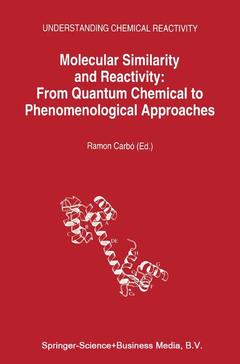Molecular Similarity and Reactivity, Softcover reprint of hardcover 1st ed. 1995 From Quantum Chemical to Phenomenological Approaches Understanding Chemical Reactivity Series, Vol. 14
Langue : Anglais
Coordonnateur : Carbó-Dorca Ramon

In the study of various phenomena in nature, the concept of similarity plays a fundamental role. Chemistry is no exception; the similarity of molecules, both in their physical properties and in their chemical reactions, provides a basis for their classification, characterization, and scientific description. Ultimately, the recognition and analysis of molecular similarities serve as the basis of an understanding of molecular structures and properties, and rep resent the first steps in the development of theoretical models explaining chemical behavior. In this role, molecular similarity is the foundation of predictive models in chemistry. Molecular similarity and molecular reactivity are strongly related. Studying the reactivities of molecules is an important tool for detecting molecular similarities and differences; alternatively, similar molecular properties often imply similar reactivities. This latter aspect is of special value, allowing chemists to make predictions concerning the outcomes of chemical reactions based on molecular similarities. In this book, the central theme, molecular similarity, is discussed from a variety of viewpoints covering the range from rigorous quantum chemical approaches to phenomenological observations expressed within appropriate physical and mathematical frameworks. The authors of the various chapters represent some of the most current fields of research on molecular similarity. It is the hope of the editor that by bringing these subjects together under the cover of this book will provide the readers with a broad perspective and a handy reference of the contemporary approaches to similarity analysis of molecules and reactions.
Section A: Quantum Chemical Foundation.- Theoretical Foundation of Quantum Molecular Similarity.- Molecular Similarity and Momentum Space.- Molecular Similarity Measures for Assessing Reactivity.- Electron Density Approximations for the Rapid Evaluation of Quantum Molecular Similarity Measures.- Section B: Computational Methods.- General Suggestions and Applications of Quantum Molecular Similarity Measures from ab initio Fitted Electron Densities.- Quantitative Measurement of Molecular Similarity Using Shape Descriptors.- PROTEP: A Program for Graph-Theoretical Similarity Searching of the 3-D Structures in the Protein Data Bank.- 3D Molecular Similarity Modelling in Computational Drug Design.- Application of Adaptive Mixture of Local Neural Networks in Chemistry. Prediction and Classification of Resonance and Inductive Effects of Substituents.- Section C: Phenomenological Approaches.- A Proven Performer in the Similarity Stakes.- Graph Theoretical Approach to Structural Changes in Chemistry.- Detection of the Largest Patterns Common to a Set of Molecules, Using 2D Graphs and 3D Skeletons.- A Proposal Toward the Identification of Substructure Electronic Similarity.- Study of the Root Mean Square Deviations of Bond Lengths, Bond Angles and Torsional Angles as a Measure of Molecular Similarities.- Molecular Similarity and LFER.- Evaluation of Molecular Similarity Using Topological Fragment Spectra.
Date de parution : 12-2010
Ouvrage de 324 p.
15.5x23.5 cm
© 2024 LAVOISIER S.A.S.



